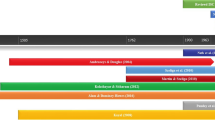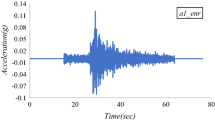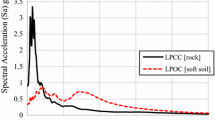Abstract
This paper aims to improve the site classification scheme and amplification factors for the Indian Seismic Code. The present code IS 1893 (1):2016 ignores the amplification of effective peak ground acceleration due to the existence of soft soil layers. This results in lower design spectral accelerations on soil sites compared to those adopted by codes in other nations. 124 well documented sites from India are considered for ground response analysis using the equivalent linear procedure of DEEPSOIL. Time histories recorded from India and abroad are made spectrum compatible with the Type I spectra of Indian code, corresponding to all the seismic intensities with Effective Peak Ground Acceleration of 0.1 g, 0.16 g, 0.24 g and 0.36 g. Statistical methods are used to construct mean, mean plus standard deviation and mean minus standard deviation response spectra and amplification factors for the sites considered. Before the statistical analysis, each amplification factor curve is normalized with the effective site period (Tg) which exhibits a “characteristic peak at values of T/Tg not far from 1”. Normalized acceleration response spectra as well as period dependent soil amplification factors and equations are proposed for the new classification system. It is observed that the stratigraphy, impedance contrast, sediment thickness and site period play an important role in determining the soil amplification factors and therefore, should be considered in the future site classification schemes of the Indian Seismic Code.






















Similar content being viewed by others
References
Abrahamson NA (1992) Non-stationary spectral matching. Seismol Res Lett 63:30
Adhikary S, Singh Y (2012) Limitations of soil amplification provisions in the 2002 Indian seismic code. J Earthq Eng 16:1–14. https://doi.org/10.1080/13632469.2011.594485
Adhikary S, Singh Y (2019) Effect of site amplification on inelastic seismic response. Earthq Eng Eng Vib 18:535–554. https://doi.org/10.1007/s11803-019-0520-y
Adhikary S, Singh Y, Paul DK (2014) Effect of soil depth on inelastic seismic response of structures. Soil Dyn Earthq Eng 61–62:13–28. https://doi.org/10.1016/j.soildyn.2014.01.017
Anbazhagan P, Thingbaijam KKS, Nath SK et al (2010) Multi-criteria seismic hazard evaluation for Bangalore city, India. J Asian Earth Sci 38:186–198
ASCE 7 (2017) Minimum design loads for buildings and other structures. American Society of Civil Engineers, Reston
Boominathan A, Dodagoudar GR, Suganthi A, Maheswari R (2008) Seismic hazard assessment of Chennai city considering local site effects. J Earth Syst Sci 117:853–863. https://doi.org/10.1007/s12040-008-0072-4
Boore DM (1983) Stochastic simulation of high-frequency ground motions based on seismological models of the radiated spectra. Bull Seismol Soc Am 73:1865–1894
Boore DM (2003) Simulation of ground motion using the stochastic method. Pure appl Geophys 160:635–676
Borcherdt RD (1994) Estimates of site-dependent response spectra for design (methodology and jostification). Earthq Spectra 10:617–653
Cadet H, Bard P-Y, Duval A-M, Bertrand E (2012a) Site effect assessment using KiK-net data: part 2—site amplification prediction equation based on f0 and Vsz. Bull Earthq Eng 10:451–489. https://doi.org/10.1007/s10518-011-9298-7
Cadet H, Bard P-Y, Rodriguez-Marek A (2012b) Site effect assessment using KiK-net data: part 1. A simple correction procedure for surface/downhole spectral ratios. Bull Earthq Eng 10:421–448. https://doi.org/10.1007/s10518-011-9283-1
Chatterjee K (2018) Impact of ground response analysis on seismic behavior and design of piles in Kolkata city. Indian Geotech J 48:459–473. https://doi.org/10.1007/s40098-017-0264-4
Chatterjee K, Choudhury D (2018) Influences of local soil conditions for ground response in Kolkata city during earthquakes. Proc Natl Acad Sci India Sect A Phys Sci 88:515–528. https://doi.org/10.1007/s40010-016-0265-1
Clough RW, Penzien J (1975) Dynamics of structures. McGraw Hill, New York
Desai SS, Choudhury D (2015) Site-specific seismic ground response study for nuclear power plants and ports in Mumbai. Nat Hazards Rev 16:04015002. https://doi.org/10.1061/(ASCE)NH.1527-6996.0000177
Dobry R, Oweis I, Urzua A (1976) Simplified procedures for estimating the fundamental period of a soil profile. Bull Seismol Soc Am 66:1293–1321
Elayaraja S, Chandrasekaran SS, Ganapathy GP (2015) Evaluation of seismic hazard and potential of earthquake-induced landslides of the Nilgiris, India. Nat Hazards 78:1997–2015. https://doi.org/10.1007/s11069-015-1816-5
Eurocode 8 (2004) Design of structures for earthquake resistance—part I: general rules, seismic actions and rules for buildings. European Committee for Standardization, Brussels
Gallipoli MR, Mucciarelli M (2009) Comparison of site classification from VS30, VS10, and HVSR in Italy. Bull Seismol Soc Am 99:340–351. https://doi.org/10.1785/0120080083
Govindaraju L, Bhattacharya S (2008) Site response studies for seismic hazard analysis of Kolkata city. In: The 12th international conference of international association for computer methods and advances in geomechanics (IACMAG). pp 2899–2907
GovindaRaju L, Ramana GV, HanumanthaRao C, Sitharam TG (2004) Site-specific ground response analysis. Curr Sci 87:1354–1362
Groholski DR, Hashash YMA, Musgrove M, et al (2015) Evaluation of 1-D non-linear site response analysis using a general quadratic/hyperbolic strength-controlled constitutive model. In: 6th international conference on earthquake geotechnical engineering. Christchurch, New Zealand
Hancock J, Watson-lamprey J, Abrahamson NA et al (2006) An improved method of matching response spectra of recorded earthquake ground motion using wavelets. J Earthq Eng 10:67–89. https://doi.org/10.1080/13632460609350629
HanumanthaRao C, Ramana GV (2009) Site specific ground response analyses at Delhi. Electron J Geotech Eng, India, p 14
Harmon J, Hashash YMA, Stewart JP et al (2019a) Site amplification functions for Central and Eastern North America—part II: modular simulation-based models. Earthq Spectra 35:815–847. https://doi.org/10.1193/091117EQS179M
Harmon J, Hashash YMA, Stewart JP et al (2019b) Site amplification functions for Central and Eastern North America—part I: simulation data set development. Earthq Spectra 35:787–814. https://doi.org/10.1193/091017EQS178M
Hashash YMA, Musgrove MI, Harmon JA, et al (2016) DEEPSOIL 6.1, User Manual
Hough SE, Martin S, Bilham R, Atkinson GM (2002) The 26 January 2001 M 7.6 Bhuj, India, Earthquake: observed and predicted ground motions. Bull Seismol Soc Am 92:2061–2079. https://doi.org/10.1785/0120010260
Idriss IM (1990) Response of soft soil site during earthquakes. In: Duncan JM (ed) Proceedings of H. Bolton seed memorial symposium, vol 2. University of California, Berkeley, pp 273–289
IS 1893(1) (2016) Criteria for earthquake resistant design of structures. Bureau of Indian Standards, New Dehli
Jain S, Gupta ID (2012) Investigation of commonly used theoretical methods for modelling of soil amplification effects. In: ISET golden jubilee symposium indian society of earthquake technology. Roorkee, p Paper No. A009
Jishnu R, Naik SP, Patra NR, Malik JN (2013) Ground response analysis of Kanpur soil along Indo-Gangetic Plains. Soil Dyn Earthq Eng 51:47–57. https://doi.org/10.1016/j.soildyn.2013.04.001
Kamatchi P, Rajasankar J, Iyer NR et al (2010a) Effect of depth of soil stratum on performance of buildings for site-specific earthquakes. Soil Dyn Earthq Eng 30:647–661. https://doi.org/10.1016/j.soildyn.2010.02.007
Kamatchi P, Ramana GV, Nagpal AK (2010b) Importance of site-specific studies for medium soil sites of Delhi region. ISET J Earthq Technol 47:61–74
Kanth STGR, Iyengar RN (2007) Estimation of seismic spectral acceleration in Peninsular India. J Earth Syst Sci 116:199–214. https://doi.org/10.1007/s12040-007-0020-8
Kim B, Hashash YMA, Stewart JP et al (2016) Relative differences between nonlinear and equivalent-linear 1-D site response analyses. Earthq Spectra 32:1845–1865. https://doi.org/10.1193/051215EQS068M
Kumar SS, Dey A, Krishna AM (2014) Equivalent linear and nonlinear ground response analysis of two typical sites at Guwahati city. Indian Geotech Conf. Kakinada, India, pp 1–10
Lang DH (2004) Damage potential of seismic ground motion considering local site effects. Bauhaus University Weimar, Weimar
Lermo J, Chávez-Garcia FJ (1993) Site effect evaluation using spectral ratios with only one station. Bull Seismol Soc Am 83:1574–1594
MacMurdo J (1824) XXI. Papers relating to the earthquake which occurred in India in 1819: to William Erskine, Esq. & c. Bombay. Philos Mag 63:105–119
Mahajan AK, Slob S, Ranjan R et al (2007) Seismic microzonation of Dehradun City using geophysical and geotechnical characteristics in the upper 30 m of soil column. J Seismol 11:355–370. https://doi.org/10.1007/s10950-007-9055-1
Maheswari RU, Boominathan A, Dodagoudar GR (2010a) Use of surface waves in statistical correlations of shear wave velocity and penetration resistance of Chennai soils. Geotech Geol Eng 28:119–137. https://doi.org/10.1007/s10706-009-9285-9
Maheswari RU, Boominathan A, Dodagoudar GR (2010b) Seismic site classification and site period mapping of Chennai City using geophysical and geotechnical data. J Appl Geophys 72:152–168. https://doi.org/10.1016/j.jappgeo.2010.08.002
Mandal HS, Khan PK, Shukla AK (2014) Soil responses near Delhi ridge and adjacent regions in Greater Delhi during incidence of a local earthquake. Nat Hazards 70:93–118. https://doi.org/10.1007/s11069-012-0098-4
Matasovic N (1993) Seismic response of composite horizontally-layered soil deposits. University of California at Los Angeles, Los Angeles
MATLAB R2014a The MathWorks, Inc. Natick, Massachusetts, United States
Mittal H, Kumar A, Ramhmachhuani R (2012) Indian national strong motion instrumentation network and site characterization of its stations. Int J Geosci 03:1151–1167. https://doi.org/10.4236/ijg.2012.326117
Naik NP, Choudhury D (2014) Comparative study of seismic ground responses using DEEPSOIL, SHAKE, and D-MOD for soils of Goa, India. In: Geo-Congress 2014. pp 1101–1110
Nakamura Y (1989) A method for dynamic characteristics estimation of subsurface using microtremor on the ground surface. Railw Tech Res Inst Q Rep 30
NZS 1170.5 (2004) Structural design actions, part 5: earthquake actions. New Zealand, Standards, Wellington, New Zealand
Pandey B, Jakka RS, Kumar A (2016) Influence of local site conditions on strong ground motion characteristics at Tarai region of Uttarakhand, India. Nat Hazards 81:1073–1089. https://doi.org/10.1007/s11069-015-2120-0
Papaspiliou M, Kontoe S, Bommer JJ (2012) An exploration of incorporating site response into PSHA-part II: sensitivity of hazard estimates to site response approaches. Soil Dyn Earthq Eng 42:316–330. https://doi.org/10.1016/j.soildyn.2012.05.001
Paul S, Dey AK (2008) Dynamic properties and ground response analysis of Silchar Soil in North-East India. Indian Geotech J 38:393–412
Pavel F, Vacareanu R, Pitilakis K (2019) Intensity-dependent site amplification factors for Vrancea intermediate-depth earthquakes. Bull Earthq Eng 17:2363–2380. https://doi.org/10.1007/s10518-019-00563-x
Pavel F, Vacareanu R, Pitilakis K, Anastasiadis A (2020) Investigation on site-specific seismic response analysis for Bucharest (Romania). Bull Earthq Eng. https://doi.org/10.1007/s10518-020-00789-0
Phanikanth VS, Choudhury D, Reddy GR (2011) Equivalent-linear seismic ground response analysis of some typical sites in Mumbai. Geotech Geol Eng 29:1109–1126. https://doi.org/10.1007/s10706-011-9443-8
Phillips C, Hashash YMA (2009) Damping formulation for nonlinear 1D site response analyses. Soil Dyn Earthq Eng 29:1143–1158. https://doi.org/10.1016/j.soildyn.2009.01.004
Pitilakis K, Gazepis C, Anastasiadis A (2004) Design response spectra and soil classification for seismic code provisions. In: 13th world conference on earthquake engineering. Vancouver, B.C., Canada, p Paper No. 2904
Pitilakis K, Riga E, Anastasiadis A (2013) New code site classification, amplification factors and normalized response spectra based on a worldwide ground-motion database. Bull Earthq Eng 11:925–966. https://doi.org/10.1007/s10518-013-9429-4
Pitilakis K, Riga E, Anastasiadis A et al (2018) Towards the revision of EC8: proposal for an alternative site classification scheme and associated intensity dependent spectral amplification factors. Soil Dyn Earthq Eng. https://doi.org/10.1016/j.soildyn.2018.03.030
Raghu Kanth STG, Sreelatha S, Dash SK (2008) Ground motion estimation at Guwahati city for an Mw 8.1 earthquake in the Shillong plateau. Tectonophysics 448:98–114. https://doi.org/10.1016/j.tecto.2007.11.028
Ranjan R (2005) Seismic response analysis of Dehradun city, India. Indian Institute of Remote Sensing, National Remote Sensing Agency (NRSA), Dehradun
Rao NP, Kumar MR, Seshunarayana T et al (2011) Site amplification studies towards seismic microzonation in Jabalpur urban area, central India. Phys Chem Earth 36:1247–1258. https://doi.org/10.1016/j.pce.2011.01.002
Régnier J, Cadet H, Bonilla LF et al (2013) Assessing nonlinear behavior of soils in seismic site response: statistical analysis on KiK-net strong-motion data. Bull Seismol Soc Am 103:1750–1770
Roblee C, Chiou B (2004) A proposed Geoindex model for design selection of non-linear properties for site response analysis. In: International workshop on uncertainties in nonlinear soil properties and their impact on modeling dynamic soil response, 18–19 March. PEER Headquarters, UC Berkeley
Rodriguez-Marek A, Bray JD, Abrahamson NA (2001) An empirical geotechnical seismic site response procedure. Earthq Spectra 17:65–87. https://doi.org/10.1193/1.1586167
Sapra RL (2014) Using R2 with caution. Curr Med Res Pract 4:130–134. https://doi.org/10.1016/j.cmrp.2014.06.002
Schnabel PB (1972) SHAKE: A computer program for earthquake response analysis of horizontally layered sites. EERC Rep 72-12, Univ California, Berkeley
Shukla J, Choudhury D (2012) Seismic hazard and site-specific ground motion for typical ports of Gujarat. Nat Hazards 60:541–565. https://doi.org/10.1007/s11069-011-0042-z
Sitharam TG, Anbazhagan P (2007) Seismic hazard analysis for the Bangalore region. Nat Hazards 40:261–278. https://doi.org/10.1007/s11069-006-0012-z
Sitharam TG, Anbazhagan P (2008) Seismic microzonation : principles, practices and experiments. Electron J Geotech Eng Special 8:61
Sitharam TG, Srinivasa Murthy BR, Aravind K (2001) A post-mortem of the collapse of structures in Ahmedabad during the Bhuj earthquake. In: Proc. Indian Geotech. Conf. pp 344–347
Sun JI, Golesorkhi R, Seed HB (1988) Dynamic moduli and damping ratios for cohesive soils. EERC Report No. UCB/EERC-88/15
Vucetic M, Dobry R (1991) Effect of soil plasticity on cyclic response. J Geotech Eng ASCE 117:89–107
Zhao JX, Irikura K, Zhang J et al (2006) An empirical site-classification method for strong-motion stations in Japan using H/V response spectral ratio. Bull Seismol Soc Am 96:914–925
Acknowledgements
The financial assistance provided by the Science and Engineering Research Board (SERB) a statutory body of the Department of Science and Technology (DST), Government of India, under the Early Career Research Award No. ECR/2016/001316 is highly acknowledged. The authors would like to thank the two anonymous reviewers for their valuable and constructive comments to improve the manuscript.
Author information
Authors and Affiliations
Corresponding author
Additional information
Publisher's Note
Springer Nature remains neutral with regard to jurisdictional claims in published maps and institutional affiliations.
Rights and permissions
About this article
Cite this article
Deoda, V.R., Adhikary, S. A preliminary proposal towards the revision of Indian seismic code considering site classification scheme, amplification factors and response spectra. Bull Earthquake Eng 18, 2843–2889 (2020). https://doi.org/10.1007/s10518-020-00806-2
Received:
Accepted:
Published:
Issue Date:
DOI: https://doi.org/10.1007/s10518-020-00806-2




